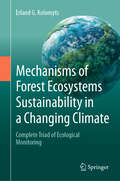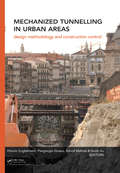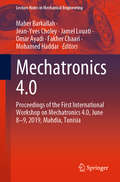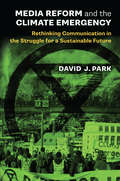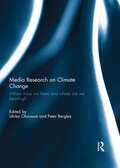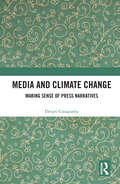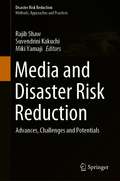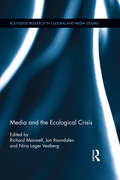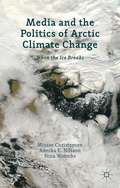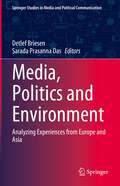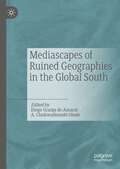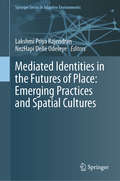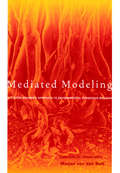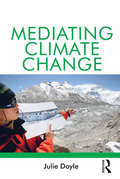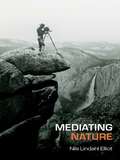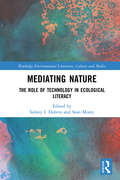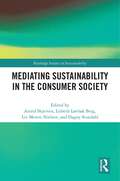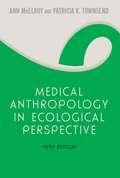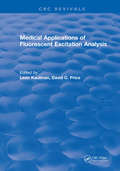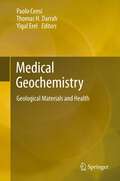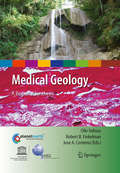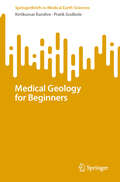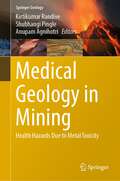- Table View
- List View
Mechanisms of Forest Ecosystems Sustainability in a Changing Climate: Complete Triad of Ecological Monitoring
by Erland G. KolomytsThe author's working concept of geo-ecological monitoring is presented. For the first time, the full triad of monitoring in its classical definition is considered: "observation (state assessment) – control (prediction) – management (adaptation, feedback, regulation)". The strategic goal of described monitoring research is to reveal the environmental otential of sustainablility of forest ecosystems in the context of modern global warming. The monograph expounds the main statements of author’s topo-ecological predictive concept: “Global Changes on the Local Level”, as a basis of ground bio-ecological and geosystem monitoring of natural ecosystems under global anthropogenic climatic changes. This concept makes it possible to carry out local empirical simulation of the regional bioclimatic trend and thereby reveal the mechanisms of transmission of global and regional climate signals to the local level. On the example of the Volga River basin, predictive empirical-statistical models of the carbon balance of forest ecosytems are presented under conditions of a changing climate. The carbon content in various pools of boreal and nemoral forests were calculated. The global climate models give prognostic estimates of the components of them carbon balance. A quantitative assessment of the ecological resources of forest formations that provide the environment sustainability through mechanisms of regulation of the carbon cycle is given. The adaptation of forest ecosystems to climate change is described through the calculated parameters of their functional sustainability.
Mechanized Tunnelling in Urban Areas: Design methodology and construction control
by Piergiorgio Grasso Vittorio Guglielmetti Ashraf Mahtab Shulin XuInternationally, the mechanized excavation of tunnels has intensified in the last two decades, as the number of tunnels being constructed for subways and railway underpasses increases. The subject of mechanized tunnelling in urban areas has not previously received the attention that it deserves, despite there being specific hazards associated with the construction of tunnels in metropolitan areas, including poor ground conditions, water tables higher than the level of tunnels, and subsidence leading to damage to the existing structures on the surface. The application of technologies for achieving the stability of the tunnel and for minimizing surface settlement is described in this book. Accurate characterization of the ground; rigorous assessment and management of risk from design to maintenance; the correct choice of a tunnel boring machine and a plan for the advancement of the tunnel; specific excavation procedures and real-time monitoring of excavation parameters are all discussed in this thorough work.
Mechatronics 4.0: Proceedings of the First International Workshop on Mechatronics 4.0, June 8–9, 2019, Mahdia, Tunisia (Lecture Notes in Mechanical Engineering)
by Jean-Yves Choley Fakher Chaari Mohamed Haddar Maher Barkallah Jamel Louati Omar AyadiThis book gathers original findings, both theoretical and experimental, related to various cutting-edge topics in the design and modeling of mechatronic systems, including multiphysics problems. It presents peer-reviewed papers from the first installment of the Mechatronics 4.0 workshop, which was jointly organized by the Laboratory of Mechanics, Modeling and Manufacturing (LA2MP), National School of Engineers of Sfax, Tunisia, and the QUARTZ Laboratory, Higher Institute of Mechanics of Paris, SUPMECA, France. The event follows in the tradition of the Workshop on Mechatronic Systems (JSM2014), organized by the same universities, while shifting the focus to the concept of Industry 4.0. As this new type of industry is emerging as the convergence of the virtual world, digital design, and management with real-world products and objects, the chapters gathered here highlight recent work on mechatronics systems that are expected to help shape the industry of tomorrow. Thanks to a healthy balance of theory and practical findings, the book offers a timely snapshot for the research and industrial communities alike, as well as a bridge to facilitate communication and collaboration between the two groups.
Media Reform and the Climate Emergency: Rethinking Communication in the Struggle for a Sustainable Future
by David ParkAward-winning author David J. Park argues that the battle against global warming is also a fight for media reform. With his new book Media Reform and the Climate Emergency: Rethinking Communication in the Struggle for a Sustainable World, he critically examines how advertising, the digital infrastructure, and journalism advance the climate emergency and lays out a path of reform to help create a more sustainable world. The production and consumption of goods and services within consumer societies lead to unsustainable greenhouse gas emissions, and Park finds that much of mass communication is either dependent upon or closely tied to the success of this social organization. As a result, he suggests successful environmental movements creatively dismantle or reform institutional infrastructures that extend the planetary global warming crisis and the unsustainable consumption of nature. Communication policies and industries are part of these infrastructures. Advertising evolved to propel a new consumer society that would encourage the over-consumption of goods and services with harmful and unsustainable production processes. Our digital infrastructure is largely premised upon the surveillance of online consumer habits and preferences, with the goal to create individualized messages to more effectively persuade people to increase their consumption habits. Much of commercial journalism resists the drastic and immediate regulatory changes necessary to address the worst aspects of this crisis. This is because so many of the needed changes challenge the media’s source of income, their libertarian philosophy, and the general status quo, which is preferred by elites. Bound to foster conversations among scholars, activists, politicians, and those who work in the communication industries, this book rethinks mass communication and highlights how immediate reform is needed in the struggle for a sustainable planet.
Media Research on Climate Change: Where have we been and where are we heading?
by Ulrika Olausson and Peter BerglezResearch on media coverage of climate change, as a particular subfield of environmental communication research, has proliferated over the past decade. This book sets out to consider what conclusions can be drawn in light of the existing body of work, what lessons can be learnt, what are the challenges to be met, and what are the directions to be taken in order to further develop media research on climate change. The mixture of articles in this volume serve well to illustrate the range of empirical, theoretical, and methodological approaches subsumed under the broad heading of "media studies on climate change." Some contributions focus on the past—how the subfield has developed and what we can learn from that—and some look toward the future. Either way, all the authors share the ambition to suggest important avenues of research, be they centered on media, context, applicability of results, or theoretical advancement. As such they make a valuable contribution to identifying important directions for future research on the role of the media in communicating climate change. This book was previously published as a special issue of Environmental Communication.
Media and Climate Change: Making Sense of Press Narratives
by Deepti GanapathyThis book looks at the media’s coverage of climate change and investigates its role in representing the complex realities of climate uncertainties and its effects on communities and the environment. The book explores the socio-economic and cultural understanding of climate issues, the influence of environment communication via the news and the public response to it. It also examines the position of the media as facilitator between scientists, policy makers and the public. Drawing extensively from case studies, personal interviews, comparative analysis of international climate coverage, and a close reading of newspaper reports and archives, the author studies the pattern and frequency of climate coverage in the Indian media and their outcomes. With a special focus on the Western Ghats, the book also discusses political rhetoric, policy parameters and events which trigger a debate about development over biodiversity crisis and environmental risks in India. This book will be of great interest to scholars and researchers of environmental studies, especially climate change, media studies, public policy and South Asian studies as well as a conscientious citizen who deeply cares for the environment.
Media and Disaster Risk Reduction: Advances, Challenges and Potentials (Disaster Risk Reduction)
by Rajib Shaw Suvendrini Kakuchi Miki YamajiThis book analyzes recent advances, trends, challenges and potentials of the role of media in disaster risk reduction. Collaboration, co-design and co-delivery with other stakeholders in science technology, private sectors, and civil society are found to be effective in reaching people and communities.The media is considered to be of utmost importance in all phases of disasters, before, during and after, with different types of media having different proactive roles to play in disaster risk reduction. Before disasters, they play essential roles not only in bringing early warning to people but also in enhancing their perception of the need to take action. At during- and post-disaster response recovery phases, community radio and social media are the key. These necessitate a resilient media infrastructure as the core of uninterrupted coverage. Media literacy has become an important issue for several stakeholders, including governments. In addition, more focus is placed on media governance to look at the priorities of disaster risk reduction initiatives within the media. All of these are considered to lead to trust in the media, which further improves people’s disaster response actions based on information from the media, before and during disasters. Covering different aspects of media, this book is a valuable source for students, researchers, academics, policy-makers and development practitioners.
Media and the Ecological Crisis (Routledge Research in Cultural and Media Studies)
by Richard Maxwell Jon Raundalen Nina Lager VestbergMedia and the Ecological Crisis is a collaborative work of interdisciplinary writers engaged in mapping, understanding and addressing the complex contribution of media to the current ecological crisis. The book is informed by a fusion of scholarly, practitioner, and activist interests to inform, educate, and advocate for real, environmentally sound changes in design, policy, industrial, and consumer practices. Aligned with an emerging area of scholarship devoted to identifying and analysing the material physical links of media technologies, cultural production, and environment, it contributes to the project of greening media studies by raising awareness of media technology’s concrete environmental effects.
Media and the Politics of Arctic Climate Change
by Miyase Christensen Annika E. Nilsson Nina WormbsCombining multidisciplinary perspectives and new research, this volume goes beyond broad discussions of the impacts of climate change and reflects on the current and historical mediations and narratives that are part of creating this new social and scientific reality.
Media, Politics and Environment: Analyzing Experiences from Europe and Asia (Springer Studies in Media and Political Communication)
by Detlef Briesen Sarada Prasanna DasEnvironmental protection has not equally established itself as a permanent fixture in the political systems of all countries: to date, governments and entire societies have responded to environmental challenges in a variety of ways, and concrete environmental policy is still a highly national matter. Moreover, the perception of environmental problems varies considerably on a global scale. The reasons normally cited for these differences largely stem from the environmental policy debates themselves, e.g. poverty, ignorance, capital interests, etc. In contrast, this book shows that concrete environmental policy emerges from a complex interplay of mass media and political conflicts: first, the mass media provide the framework for national environmental policy through agenda-setting, framing and scandalization; second, the mass media thereby change values in the political and social discourse, e.g. by altering the perception of global commons and expanding the possibilities of interest articulation; and third, this can lead to political decision-making processes in which legal and other measures for environmental protection are enforced. The book systematically compares industrialized countries such as Germany and Japan with several rapidly emerging countries in South and Southeast Asia.
Mediascapes of Ruined Geographies in the Global South
by Diego Granja do Amaral A. Chukwudumebi ObuteThis book undertakes an interdisciplinary and cross-cultural interrogation of the Global South through the prisms of media and cultural studies. It closely explores the quotidian (re)territorialization, and brazen ruination of the material geographies of this vast expanse of the world by forces and proxies of (neo)colonialism and global capitalism of resource extraction. We cite the ongoing expulsion of Palestinians from their homelands by occupational forces, the emerging detritus dump across Mexico City and Lagos, the infrastructural precariousness of the favelas of Brazil, the unending resource-war in the Democratic Republic of Congo (DRC), and the flagrant operation of the oil industry in the Niger Delta region of Nigeria as examples of this geographic cataclysm. The centripetal forces of neo-colonialism and resource extraction at full-flight in the Global South, aided by toxic hegemonic forces, have overtly tossed some of the population to the peripheries of existence and the society at large. As such, this book, additionally, explores the resistance of the subalterns from the margins to this socio-political malaise, and further unmasks the knowledge production from these margins of the Global South. This project is divided into five (5) parts of three essays each. The first part examines the territorial contestation in the Middle East framed and expressed through films and literary lenses. The second part examines the environmental burden of modern consumerism and urbanization on metropolis across Mexico, Brazil, and Nigeria, while the third part explores the attritional violence of resource extraction in the DRC, Brazil, and Nigeria via filmic and journalistic lenses. The fourth part offers a swift response from the margins through ethnographic and journalistic interrogation of the subjectivity of the subalterns of Brazilian favelas, and street artists. The fifth part offers an engaging critique of the political climates of South Africa and Brazil that reinforce the environmental catastrophe of the regions of the world.
Mediated Identities in the Futures of Place: Emerging Practices and Spatial Cultures (Springer Series in Adaptive Environments)
by Lakshmi Priya Rajendran NezHapi Dellé OdeleyeThis book examines the emerging problems and opportunities that are posed by media innovations, spatial typologies, and cultural trends in (re)shaping identities within the fast-changing milieus of the early 21st Century.Addressing a range of social and spatial scales and using a phenomenological frame of reference, the book draws on the works of Heidegger, Merleau-Ponty and Don Hide to bridge the seemingly disparate, yet related theoretical perspectives across a number of disciplines. Various perspectives are put forward from media, human geography, cultural studies, technologies, urban design and architecture etc. and looked at thematically from networked culture and digital interface (and other) perspectives.The book probes the ways in which new digital media trends affect how and what we communicate, and how they drive and reshape our everyday practices. This mediatization of space, with fast evolving communication platforms and applications of digital representations, offers challenges to our notions of space, identity and culture and the book explores the diverse yet connected levels of technology and people interaction.
Mediated Modeling: A System Dynamics Approach To Environmental Consensus Building
by Marjan van den Belt Thomas DietzMediated modeling is an innovative new approach that enhances the use of computer models as invaluable tools to guide policy and management decisions. Rather than having outside experts dispensing answers to local stakeholders, mediated modeling brings together diverse interests to raise the shared level of understanding and foster a broad and deep consensus. It provides a structured process based on system dynamics thinking in which community members, government officials, industry representatives, and other stakeholders can work together to produce a coherent, simple but elegant simulation model. Mediated Modeling by Marjan Van Den Belt is a practical guide to participatory modeling for both practitioners and students, one that is firmly theoretically grounded in the field of systems dynamics and environmental modeling. Five in-depth case studies describe the successful use of the technique in a variety of settings, and a final chapter synthesizes the lessons highlighted by the case studies.Mediated Modeling's step-by-step description of the techniques and practical advice regarding implementation offer a real-world solution for all those seeking to make sound decisions about the environment.
Mediating Climate Change (Environmental Sociology Ser.)
by Julie DoyleClimate change has been a significant area of scientific concern since the late 1970s, but has only recently entered mainstream culture and politics. However, as media coverage of climate change increases in the twenty-first century, the gap between our understanding of climate change and climate action appears to widen. In this timely book, Julie Doyle explores how practices of mediation and visualisation shape how we think about, address and act upon climate change. Through historical and contemporary case studies drawn from science, media, politics and culture, Mediating Climate Change identifies the representational problems climate change poses for public and political debate. It offers ways forward by exploring how climate change can be made more meaningful through, for example, innovative forms of climate activism, the reframing of meat and dairy consumption, media engagement with climate events and science, and artistic experimentation. Doyle argues that cultural discourses have problematically situated nature and the environment as objects externalised from humans and culture. Mediating Climate Change calls for a more nuanced understanding of human-environmental relations, in order for us to be able to more fully imagine and address the challenges climate change poses for us all.
Mediating Nature (International Library of Sociology)
by Nils Lindahl ElliotMediating Nature provides a history of the present nature of mass mediation. It examines the ways in which a number of discourses, technologies and institutions have historically shaped the current ways of imagining nature in the mass media. Where much of the existing research treats mass mediation as a matter of media technologies, texts, or institutions, this text adopts a somewhat different approach: it considers mass mediation as a historical process by means of which the members of audiences and indeed the public more generally came to be incorporated as observers in, and of mass culture. This approach allows the book to investigate the roles that a wide range of genres relating to nature played in constructing senses of nature but also of mass culture itself. The genres include landscape paintings and gardens, modern zoos, photography, early cinema, nature essays, disaster and ‘animal attack’ films, as well as wildlife documentaries on television. The investigation develops what Lindahl Elliot describes as a ‘social semeiotic’ approach that combines the semeiotic theory of Charles Peirce with a historical sociology of cultural formations. Topical and timely, this fascinating book will be of great interest to students and researchers in the fields of media, sociology, cultural geography and environmental studies.
Mediating Nature: The Role of Technology in Ecological Literacy (Routledge Environmental Literature, Culture and Media)
by Sean Morey Sidney I. DobrinMediating Nature considers how technology acts as a mediating device in the construction and circulation of images that inform how we see and know nature. Scholarship in environmental communication has focused almost exclusively on verbal rather than visual rhetoric, and this book engages ecocritical and ecocompositional inquiry to shift focus onto the making of images. Contributors to this dynamic collection focus their efforts on the intersections of digital media and environmental/ecological thinking. Part of the book’s larger argument is that analysis of mediations of nature must develop more critical tools of analysis toward the very mediating technologies that produce such media. That is, to truly understand mediations of nature, one needs to understand the creation and production of those mediations, right down to the algorithms, circuit boards, and power sources that drive mediating technologies. Ultimately, Mediating Nature contends that ecological literacy and environmental politics are inseparable from digital literacies and visual rhetorics. The book will be of interest to scholars and students working in the fields of Ecocriticism, Ecocomposition, Media Ecology, Visual Rehtoric, and Digital Literacy Studies.
Mediating Sustainability in the Consumer Society (Routledge Studies in Sustainability)
by Dagny Stuedahl Astrid Skjerven Lisbeth Løvbak Berg Liv Merete NielsenThis book sheds light on the role and impact of sustainability mediation, an effective tool for political authorities and business enterprises to persuade consumers of the integrity of their actions, products, and services.In this era of ecological and societal crises fuelled by increasing consumption, sustainability has become a key buzzword and target to attain. Governments around the world argue that they will meet their sustainability goals through environmental actions, by enabling consumers to make better choices and expecting brands to respond accordingly. At the same time, consumers are overwhelmed by the messaging conveyed in sustainability marketing campaigns, often featuring misleading greenwashing, with political authorities, organisations, and business enterprises all having conflicting interests. In this complex scenario, mediation has become a crucial issue. This book offers a critical and multidisciplinary view of sustainability mediation from experts in the fields of philosophy, consumption research, media studies, fashion, design, and citizenship, offering a unique, holistic view. Each chapter highlights different and problematic aspects of the cultural narratives being communicated, for example, the necessity of growth and the notion of a green economy. They present current theories, methods, indicators, and strategies used to assess and measure the relation between mediation, behaviour, and sustainable development.This book is of interest to scholars, researchers, and postgraduate students in all subject fields concerned with sustainability, including design, visual communication, fashion, consumption, media and journalism, and sustainable development.
Medical Anthropology in Ecological Perspective
by Ann Mcelroy Patricia K TownsendWidespread awareness of emerging infectious diseases and global environmental change makes the ecological perspective of this premier teaching text for medical anthropology as relevant as ever. Integrating biocultural, environmental, and evolutionary approaches to the study of human health, this fifth edition is now thoroughly revised to reflect new developments in the field. Research by human biologists and paleopathologists illuminates the history and prehistory of disease, while the work of cultural and applied anthropologists addresses contemporary health issues. The fifth edition features five new profiles by guest contributors, all leading researchers on health and environment. New topics include community health and disease prevention in urban America; water-borne disease in Ecuador; iodine deficiency in the Himalaya; stress and demographic change in northern Siberia; and participatory action research in Costa Rica. Also included is updated and expanded consideration of refugee health, global aspects of HIV/AIDS, and careers in applied medical anthropology.
Medical Anthropology in Ecological Perspective
by Ann Mcelroy Patricia K TownsendWidespread awareness of emerging infectious diseases and global environmental change makes the ecological perspective of this premier teaching text for medical anthropology as relevant as ever. Integrating biocultural, environmental, and evolutionary approaches to the study of human health, this fifth edition is now thoroughly revised to reflect new developments in the field. Research by human biologists and paleopathologists illuminates the history and prehistory of disease, while the work of cultural and applied anthropologists addresses contemporary health issues. The fifth edition features five new profiles by guest contributors, all leading researchers on health and environment. New topics include community health and disease prevention in urban America; water-borne disease in Ecuador; iodine deficiency in the Himalaya; stress and demographic change in northern Siberia; and participatory action research in Costa Rica. Also included is updated and expanded consideration of refugee health, global aspects of HIV/AIDS, and careers in applied medical anthropology.
Medical Anthropology in Ecological Perspective
by McelroyMcElroy and Townsend (both of the State U. of New York at Buffalo) present the fifth edition of their text introducing the field of medical anthropology. Their aim is to bring together the varied strands of medical anthropology--ethnographic studies of illness beliefs, curing rituals, and herbal medicines; study of the role of disease and climate as factors in human evolution; work on cross-cultural communication in public health; and study of human relationships to their environments in contemporary settings and in the past--using an ecological model and the concept of medical ecology. They present chapters on the ecology of health and disease; interdisciplinary research in health problems; genes, culture, and adaptation; changing patterns of disease and health; the ecology and economics of nutrition; culture, ecology, and reproduction; stress, illness, and healing; health resources in changing cultures; costs and benefits of development; and medical anthropology practices in the 21st century. Interspersed throughout are 16 "profiles" (five new to this edition): case studies that illustrate points made in the rest of the text through examples of current research in medical anthropology, with examples including demographic analysis of census data in post-Soviet Siberian villages, focus group research with inner-city teens in urban Connecticut, and a team project designed to reduce the rates of cholera in rural Ecuador. Annotation ©2009 Book News, Inc. , Portland, OR (booknews. com)
Medical Applications of Fluorescent Excitation Analysis
by L. KaufmanFluorescent excitation analysis (FEA) is a technique that has been utilized for some time in physics. An increasing number of biomedical applications for FEA have been reported in recent year: it is becoming the assay method of choice in many areas of research and clinical practice. The purpose of this volume is to acquaint the interest physician or physicist with the basic principles and instrumentation relevant for FEA, as well as some present and future biomedical applications.
Medical Geochemistry
by Paolo Censi Thomas Darrah Yigal ErelThis book includes a collection of chapters illustrating the application of geochemical methods to investigate the interactions between geological materials and fluids with humans. Examples include the incorporation and human health effects of inhaling lithogenic materials, the reactivity of biological fluids with geological materials, and the impact on nascent biomineral formation. Biomineralization is investigated in terms of mineralogy, morphology, bone chemistry, and pathological significance with a focus on the health impacts of "foreign" geological/environmental trace element incorporation. One of the contribution is devoted to particulate matter, the presence of metals and metalloids in the environment, and the possibility of using human hair as a biomarker between environmental/geological exposure and human bioincorporation. Other chapters focus on the last advances on the analytical methods and instrumentational approaches to investigating the chemistry of biological fluids and tissues.
Medical Geology
by Jose A. Centeno Olle Selinus Robert B. FinkelmanMedical Geology is a rapidly growing field concerned with the relationship between natural geological factors and human and animal health, as well as with improving our understanding of the influence of environmental factors on the geographical distribution of health problems. This book brings together the work of geoscientists and medical/public health researchers, which addresses health problems caused, or exacerbated by geological materials (rocks, minerals, atmospheric dust and water) and processes (including volcanic eruptions and earthquakes. Among the environmental health problems discussed in this book are: exposure to toxic levels of trace essential and non-essential elements such as arsenic and mercury; trace element deficiencies; exposure to natural dusts and to radioactivity; naturally occurring organic compounds in drinking water; volcanic emissions, etc. The text also deals with the many health benefits of geologic materials and processes. This wide-ranging volume covers issues in medical geology all over the world with each author covering their respective region. It provides examples from different continents as well as a state-of-the-art review of the latest developments in the discipline. The authors are all recognized geoscientific and medical experts working in the field. The book is written for a wide variety of specialists from geologists, geochemists, pathologists and medical doctors to veterinarians and biologists.
Medical Geology for Beginners (SpringerBriefs in Medical Earth Sciences)
by Kirtikumar Randive Pratik GodboleThis book is created for a diverse audience that includes geologists and Earth scientists studying the impacts of geological processes on human health, as well as health professionals and medical researchers interested in the environmental determinants of health. It is also a good reference for the environmental scientists and public health policymakers focused on sustainable practices and health risk mitigation. Additionally, undergraduate and postgraduate students, research scholars, and academicians in geosciences, environmental health, and related interdisciplinary fields will find this book valuable for their studies and research. Industry professionals in mining, environmental monitoring, and disaster management will benefit from the health insights provided. Furthermore, individuals working in Ayurveda and traditional medicine will discover valuable information on the therapeutic uses of geological materials. This book explores relationship between geology and human health, providing vital insights for professionals in both the geosciences and health sciences. It delves into how natural processes, materials, and anthropogenic activities influence human health, highlighting the critical role of Medical Geology in modern science and public health. Finally, as Professor Robert Finkleman narrates, &“Medical Geology for Beginners provides an invaluable service to the science of medical geology and to anyone interested in this subject matter and especially to the young readers who may be inspired to pursue a career in medical geology&”.
Medical Geology in Mining: Health Hazards Due to Metal Toxicity (Springer Geology)
by Kirtikumar Randive Shubhangi Pingle Anupam AgnihotriThis book discusses a wide range of health-related mining issues, with particular reference to occupational diseases, metal toxicity, postural injuries in miners, modern fire safety controls, noise-induced hearing loss prevention, and noise mapping. Mining plays a central role in the development of modern civilization. By providing the essential raw materials, mining ensures progress, safety, and comfort of people. However, this necessary activity comes with several woes, the most important of which are occupational health hazards. Mines act as sources of constant danger and risk to the miners irrespective of the scale of mining, such as large-scale industrial mining or small-scale artisanal mining. Not only are there accidents, but continuous exposure to dust, metal toxicity, hazardous gases and fumes, and loud noises, giving rise to a variety of diseases to mine workers. The comprehensive coverage of issues and the case studies will make this book an essential reference and critical reading. Medical geology is a necessary discipline in earth sciences. Unfortunately, not much literature is available on this subject. Therefore, this book is essential for practicing engineers and supervisors in mines, health and safety professionals, researchers, and mining industry students.
